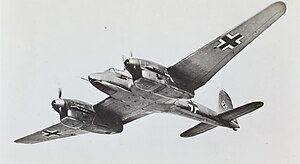Focke-Wulf Fw 187
| Fw 187 Falke | |
|---|---|
 |
|
| Role | Heavy fighter |
| Manufacturer | Focke-Wulf |
| Designer | Kurt Tank |
| First flight | May 1937 |
| Status | Not accepted for wide use |
| Primary user | Luftwaffe |
| Number built | 9 |
The Focke-Wulf Fw 187 Falke ("falcon") was a German aircraft developed in the late 1930s. It was conceived by Kurt Tank as a twin-engine, high-performance fighter, but the Luftwaffe saw no role for the design, perceiving it as intermediate between the Messerschmitt Bf 109 and Bf 110. Later prototypes were adapted to two-seats to compete with the Bf 110 in the Zerstörer (heavy fighter) role, but only nine aircraft were built in total.
In the early to mid-1930s, developments in airframe design outstripped available aircraft engine power, allowing large aircraft to be built that existing engines were unable to sufficiently lift or propel (at least not alone). A period ensued in which multi-engine designs mostly outperformed aircraft designed with just one engine. In air racing in Europe, the Dornier Do 17 outran every single-engine fighter it competed against. In Germany, this led to the idea of the "schnellbomber", fast bombers that were expected to fly right past the defensive fighters. Although this period of twin-engine superiority would be short-lived, it also led to many air forces considering twin-engine fighter designs.
In 1935, Kurt Tank made the suggestion of creating a long-range single-seat fighter under a private venture within Focke-Wulf. The idea was not to produce a heavy fighter or bomber destroyer like the Bf 110, but instead a long-range design that would have the performance of a single-seat design. Powered by the new 736 kW (1,000 PS) Daimler-Benz DB 600, it had an expected speed of 560 km/h (350 mph). The design was unveiled in 1936 at an exhibition of new weapons, prototypes and projects held at the Henschel factory at Berlin-Schönefeld, where it was viewed by a number of high-ranking Nazi officials, including Hitler. However, the Reich Air Ministry (RLM) rejected the design on the grounds that the single-engine Bf 109 had comparable performance but would cost roughly half as much. The need for a long-range design was not considered serious, as at the time it was believed bomber escort was simply not needed.
...
Wikipedia
